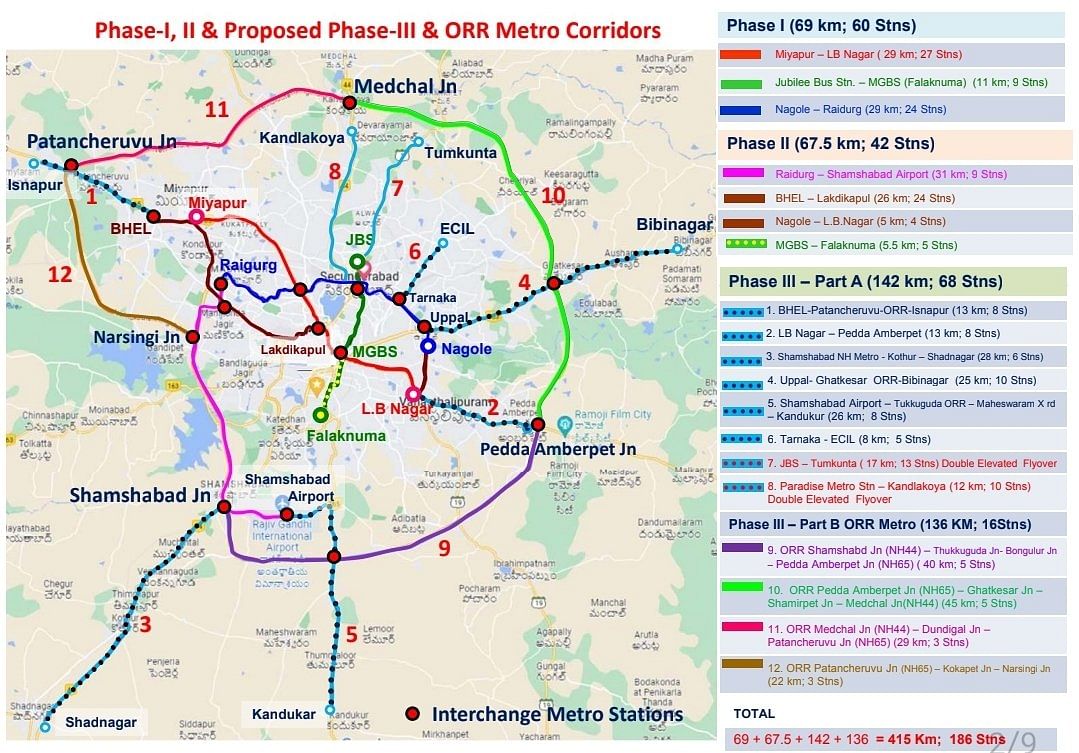Once the Phase 2 and 3 projects are fully implemented, the Hyderabad Metro Rail Limited will extend its network across the city, covering a total distance of 415 km and featuring 186 stations.
The Hyderabad Metro Rail Limited (HMRL) is set to undergo a significant expansion of over 300 km, as approved by the Telangana cabinet recently.
The estimated cost of this expansion is Rs 69,100 crore, and it is expected to be completed within five years.
Half of this project will not require the acquisition of properties, as a 25-metre right of way has already been dedicated along 156 km of the Outer Ring Road (ORR) for the metro rail.
In order to minimise costs along certain stretches of the expansion, the height of the viaduct can be kept low at just 3 metres above ground level, or even at grade level whenever possible. This approach is aimed at reducing expenses while maintaining the efficiency of the metro rail.
N V S Reddy, the managing director of HMRL, emphasised that the estimated cost of Rs 69,100 crore is not an underestimation. He explained that the elevated nature of the metro rail allows for construction at a significantly lower cost compared to other cities like Mumbai, Chennai, or Bengaluru.
In these cities, underground stretches require a budget of anywhere between Rs 600 crore to Rs 1,000 crore per km, whereas the elevated metro rail in Hyderabad can be constructed at Rs 200 crore to Rs 300 crore per km.
During an interview with Indianexpress, Reddy provided some insights into the project’s progress. He mentioned that they are still in the early stages and expect to submit the preliminary project report in about four months.
However, he also acknowledged that there will likely be changes after the preparation of the detailed project report. Therefore, at this stage, he was unable to provide detailed information about the project.
It was stated that Chief Minister K Chandrashekar Rao and Municipal Administration and Urban Development Minister K T Rama Rao have a clear vision for the project.
They believe that the project can be implemented in less than five years. The government is highly committed to this project as a solution to develop and decongest Hyderabad.
The CM’s goal is to make Hyderabad a more livable city in the future, with room for an additional one crore people. The city has 1.2 crore inhabitants presently.
The state government has made it clear that they will seek assistance from the Union government for the proposed expansion. However, even if the Centre remains unresponsive, the state government is determined to proceed with the project.
Once the phases 2 and 3 projects are fully implemented, the HMRL will extend its network across the city, covering a total distance of 415 km and featuring 186 stations.
Unlike Phase 1, which was a public-private partnership, the expansion is likely to be a government-funded project. Unless the government decides otherwise, this will be the funding model for the project.
According to Reddy, the 27 km Blue Line corridor connecting Nagole to Raidurg was not initially included in the project. However, it has now become the busiest section, with Raidurg being one of the busiest stations. This unexpected popularity highlights the importance of expanding the metro rail network in Hyderabad.
According to Reddy, there is significant development taking place on the outskirts of Hyderabad. The Chief Minister’s vision is to have people park their vehicles at Outer Ring Road (ORR) and be able to travel to any part of Hyderabad within 45 minutes to one hour.
Proposed Plan
The proposed plan for Phase 3, Part A includes six corridors covering a total of 142 km with 68 stations. One corridor will connect BHEL to Patancheruvu and Isnapur, spanning 13 km with eight stations and costing Rs 3,250 crore.
Another corridor will connect L B Nagar to Hayathnagar and Peddamberpet, covering 13 km with eight stations and costing Rs 4,500 crore.
There will also be a corridor connecting Shamshabad Junction Metro station with Kothur and Shadnagar, covering 28 km with six stations and costing Rs 6,800 crore.

Additionally, a corridor is planned to connect Uppal with Bibinagar via Ghatkesar, covering 25 km with 10 stations and costing Rs 6,900 crore. Another corridor will run from Shamshabad International Airport to Kandukur via Tukkuguda ORR and Maheshwaram X Road, covering 26 km with eight stations and costing Rs 6,600 crore.
Lastly, a corridor is planned to connect Tarnaka with ECIL X Road, covering 8 km with five stations and costing Rs 2,300 crore.
In Part B of the Phase 3 expansion, a metro corridor is planned to cover the 136 km stretch of the Outer Ring Road. This corridor will include 16 stations and does not include the Airport Metro, which is part of Phase 2 and runs along the ORR.
Under Part C of Phase 3, there are two proposed corridors. The first corridor will run from Jubilee Bus Station to Tumkunta, covering 17 km with 13 stations and costing Rs 5,690 crore.
The second corridor will run from Paradise Junction to Kandlakoya via Kompally, covering 12 km with 10 stations and costing Rs 4,400 crore. These two corridors are planned as two levels or a double-decker flyover, with one level exclusively for metro rail.


